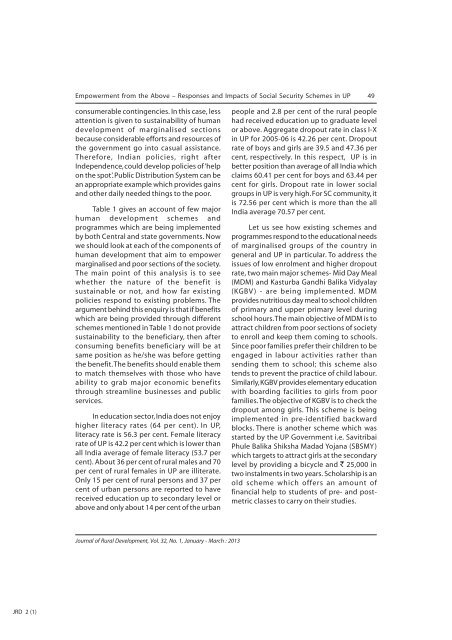January - March 2013 - National Institute of Rural Development
January - March 2013 - National Institute of Rural Development
January - March 2013 - National Institute of Rural Development
- No tags were found...
Create successful ePaper yourself
Turn your PDF publications into a flip-book with our unique Google optimized e-Paper software.
Empowerment from the Above – Responses and Impacts <strong>of</strong> Social Security Schemes in UP 49consumerable contingencies. In this case, lessattention is given to sustainability <strong>of</strong> humandevelopment <strong>of</strong> marginalised sectionsbecause considerable efforts and resources <strong>of</strong>the government go into casual assistance.Therefore, Indian policies, right afterIndependence, could develop policies <strong>of</strong> ‘helpon the spot’. Public Distribution System can bean appropriate example which provides gainsand other daily needed things to the poor.Table 1 gives an account <strong>of</strong> few majorhuman development schemes andprogrammes which are being implementedby both Central and state governments. Nowwe should look at each <strong>of</strong> the components <strong>of</strong>human development that aim to empowermarginalised and poor sections <strong>of</strong> the society.The main point <strong>of</strong> this analysis is to seewhether the nature <strong>of</strong> the benefit issustainable or not, and how far existingpolicies respond to existing problems. Theargument behind this enquiry is that if benefitswhich are being provided through differentschemes mentioned in Table 1 do not providesustainability to the beneficiary, then afterconsuming benefits beneficiary will be atsame position as he/she was before gettingthe benefit. The benefits should enable themto match themselves with those who haveability to grab major economic benefitsthrough streamline businesses and publicservices.In education sector, India does not enjoyhigher literacy rates (64 per cent). In UP,literacy rate is 56.3 per cent. Female literacyrate <strong>of</strong> UP is 42.2 per cent which is lower thanall India average <strong>of</strong> female literacy (53.7 percent). About 36 per cent <strong>of</strong> rural males and 70per cent <strong>of</strong> rural females in UP are illiterate.Only 15 per cent <strong>of</strong> rural persons and 37 percent <strong>of</strong> urban persons are reported to havereceived education up to secondary level orabove and only about 14 per cent <strong>of</strong> the urbanpeople and 2.8 per cent <strong>of</strong> the rural peoplehad received education up to graduate levelor above. Aggregate dropout rate in class I-Xin UP for 2005-06 is 42.26 per cent. Dropoutrate <strong>of</strong> boys and girls are 39.5 and 47.36 percent, respectively. In this respect, UP is inbetter position than average <strong>of</strong> all India whichclaims 60.41 per cent for boys and 63.44 percent for girls. Dropout rate in lower socialgroups in UP is very high. For SC community, itis 72.56 per cent which is more than the allIndia average 70.57 per cent.Let us see how existing schemes andprogrammes respond to the educational needs<strong>of</strong> marginalised groups <strong>of</strong> the country ingeneral and UP in particular. To address theissues <strong>of</strong> low enrolment and higher dropoutrate, two main major schemes- Mid Day Meal(MDM) and Kasturba Gandhi Balika Vidyalay(KGBV) - are being implemented. MDMprovides nutritious day meal to school children<strong>of</strong> primary and upper primary level duringschool hours. The main objective <strong>of</strong> MDM is toattract children from poor sections <strong>of</strong> societyto enroll and keep them coming to schools.Since poor families prefer their children to beengaged in labour activities rather thansending them to school; this scheme alsotends to prevent the practice <strong>of</strong> child labour.Similarly, KGBV provides elementary educationwith boarding facilities to girls from poorfamilies. The objective <strong>of</strong> KGBV is to check thedropout among girls. This scheme is beingimplemented in pre-identified backwardblocks. There is another scheme which wasstarted by the UP Government i.e. SavitribaiPhule Balika Shiksha Madad Yojana (SBSMY)which targets to attract girls at the secondarylevel by providing a bicycle and ` 25,000 intwo instalments in two years. Scholarship is anold scheme which <strong>of</strong>fers an amount <strong>of</strong>financial help to students <strong>of</strong> pre- and postmetricclasses to carry on their studies.Journal <strong>of</strong> <strong>Rural</strong> <strong>Development</strong>, Vol. 32, No. 1, <strong>January</strong> - <strong>March</strong> : <strong>2013</strong>JRD 2 (1)
















